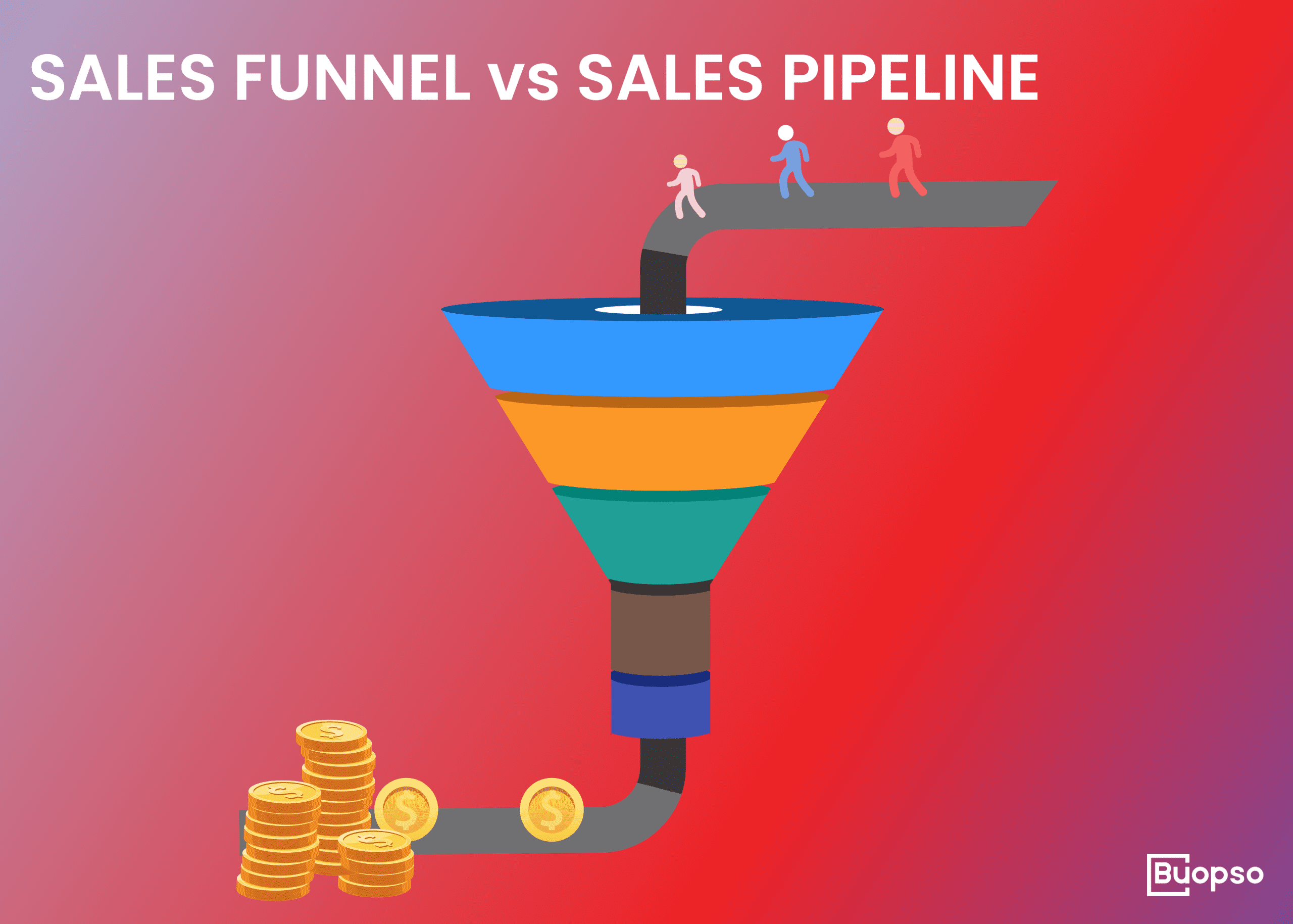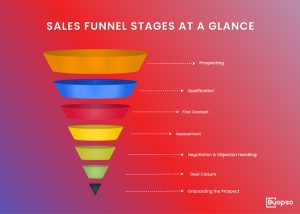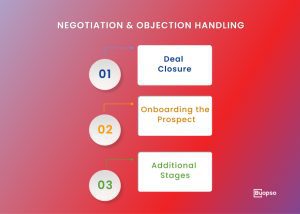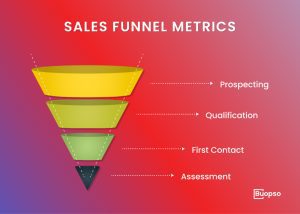Sales Funnel vs Sales Pipeline

A sales funnel and a sales pipeline are two different concepts to represent the customer journey. Sales Funnel vs Sales Pipeline helps businesses understand customer journeys and sales processes.
Imagine a funnel like a wide cone – lots of stuff goes in the top, but only some comes out the bottom. A pipeline is more like a series of boxes – things move from one box to the next.
This analogy highlights how the sales funnel measures the volume of potential customers at each stage. In contrast, the sales pipeline tracks their specific progress through the sales process.
Today, we’ll discuss the difference between a sales funnel and a sales pipeline. By understanding their unique strengths, we can identify which tools best suit your business needs and ultimately optimize your sales conversion rates.
Understanding the Sales Funnel vs Sales Pipeline
A sales funnel is a visual representation of potential customers toward becoming paying customers for your business. Sales Funnel vs Sales Pipeline emphasizes visualizing customer journeys versus managing sales stages.
Just like a funnel has a wide opening at the top and a narrow spout at the bottom, a lot of prospects undergo the top of the funnel but experience a significant drop going down due to the lead qualification. Sales Funnel vs Sales Pipeline compares focusing on lead nurturing versus opportunity tracking.
Sales Funnel Stages At a Glance
The exact stages in a sales pipeline vary from industry to industry and as per the sales methods. Having said that, there are some similarities found in most of the pipelines:

Prospecting
The very first step involves identifying the target audience. Then, generate leads using various channels and ultimately qualify to understand how suitable your product or service is for them.
Qualification
The second step involves assessing the preferences, budget, needs, and key decision-makers.
Further, finding out if the leads fall under the criteria or not (usually sales teams have their pre-defined criteria based on historical data and qualification frameworks).
First Contact
Once sales reps are done with making the most out of the data available, it’s time to make the first move by connecting with qualified leads through calls, emails, or meetings.
This stage is where you introduce your brand while understanding the challenges and goals of leads.
The aim is to build rapport and establish a connection with the potential customer.
Assessment
This stage is all about assessing the lead’s specific needs and pain points and demonstrating how your product or service is the answer that can address those needs and provide value.
Negotiation & Objection Handling
At this juncture, you need to address any concerns or objections your lead might have regarding your product or service. And, negotiate the terms of the sale, including price, contracts, and delivery timelines.

Strong negotiation and communication skills are required to streamline this stage.
Deal Closure
After negotiating and handling the objections, it’s time to secure a commitment from your lead. It comprises finalizing the sale and completing the necessary paperwork.
This stage celebrates winning the deal but also requires ensuring a smooth transition to onboarding.
Onboarding the Prospect
It includes the complete transition from a lead to a paying customer. When a deal is closed, the key to the customer journey is ensuring a successful implementation of your product or service and providing the necessary resources and support to promote satisfaction. Lastly, this stage enables making way for upselling, future purchases, and referrals.
Additional Stages
Some pipelines may include stages like opportunity management, forecasting, or renewal. These stages focus on managing sales opportunities, predicting future sales figures, and securing renewals from existing customers.
Remember, the key is to tailor your sales pipeline to your specific sales process and adapt it as needed.
Sales Pipeline Metrics
To be informed about sales performance, you need to analyze certain metrics to reach your abilities’ peak.
By analyzing these metrics, you can optimize your current pipeline and perform better in the future.
Lead Conversion Rate: Measures the percentage of leads that become customers.
Win Rate: Indicates the percentage of deals closed compared to the total number of deals pursued.
Average Sales Cycle Length: Calculates the average time it takes to close a deal.
Sales Velocity: Measures how quickly deals move through the pipeline.
Pipeline Value: Represents the total potential revenue in the pipeline at a given time.
Forecast Accuracy: Assesses the accuracy of sales forecasts.
Sales Pipeline Benefits
Visibility and Tracking
A pipeline provides a clear overview of the sales process, allowing you to track leads at different stages and ensure they are being followed up on.
Lead Management
By organizing leads into stages, you can prioritize your efforts and focus on the most promising opportunities.
Sales Forecasting
Pipelines help you estimate future revenue and make informed decisions about resource allocation.
Performance Evaluation
By analyzing the pipeline, you can measure the effectiveness of your sales efforts and identify areas for improvement.
Deal Prioritization
Pipelines help you prioritize deals based on factors like potential revenue and likelihood of closing, ensuring that your sales team is focused on the most promising opportunities.
Improved Communication
A shared pipeline can improve communication among sales team members and ensure everyone is on the same page.
Understanding the Sales Pipeline
A sales pipeline is a visual tool used to track how potential customers are progressing through the sales process to become paying customers.
It often encompasses a series of stages, similar to a pipe with water flowing through it, where leads enter from one end at the beginning and exit as a closed deal.
Sales Pipeline Stages at a Glance
Like the sales funnel, the sales pipeline also varies from industry to industry. The most common stages progress something like this:
Prospecting (or Lead Generation)
The sales pipeline begins with identifying potential customers who might benefit from your product or service, using marketing strategies, social media campaigns, email marketing, or attending industry events. The aim is to cast a wide net and attract a pool of interested leads.
Qualification
No single lead is created equal. Therefore, they require initial filtering of prospects to identify the ideal fit.
You need to assess if they are a good fit to ensure they are likely to become potential customers. This lets sales reps focus the most on promising leads.
Initial Contact
At this stage, you connect with qualified leads through phone calls, emails, or meetings and make a great first impression. With the initial contact, you introduce yourself, your company, and your solution in a way that attracts their interest and motivates them to learn more.
Proposals
Now, it’s time to delve deeper. You engage in conversations with the lead to understand their specific challenges and pain points. By presenting a tailored needs assessment and a compelling presentation that showcases how your offering addresses their unique situation, you demonstrate the value your product or service can bring.
Negotiating
The sale isn’t always a slam dunk. This stage involves addressing any concerns or objections the lead may have about your price, features, or terms. Strong negotiation and communication skills are crucial here as you work towards a mutually beneficial agreement.
Closing the Deal
This is the moment of truth! You secure a commitment from the lead to purchase your product or service. This stage involves finalizing the details and closing the sale, ensuring everyone is on the same page and excited to move forward.
Onboarding
The sale doesn’t end here! This stage focuses on integrating the new customer and ensuring a smooth onboarding experience. You provide ongoing support and resources to maximize their success and build long-term customer relationships that can lead to future sales and referrals.
Sales Funnel Metrics
Sales funnel metrics provide valuable insights into the effectiveness of your sales process, allowing you to make data-driven decisions and optimize your sales strategy. Here are some key benefits.

Drop-off Rate: Identifies the percentage of leads lost at each stage of the funnel.
Customer Acquisition Cost (CAC): Calculates the cost of acquiring a new customer.
Customer Lifetime Value (CLTV): Estimates the total revenue a customer will generate over their lifetime.
Lead-to-Customer Conversion Rate: Measures the overall efficiency of the sales funnel.
Sales Cycle Time: Calculates the average time it takes for a lead to become a customer.
Sales Funnel Benefits
Customer-centric Perspective
Sales funnels benefit the customer journey, helping businesses understand how prospects interact with their brand and proceed toward a purchase.
With so many channels online, it’s important to understand where the decision process is made, helping refine the strategy.
Optimize Conversion Rates
A sales funnel helps identify bottlenecks and areas where customers drop off, allowing for targeted improvements to increase conversion rates.
It also helps identify “most-ready” leads to improve the qualification process. After all, giving equal importance to every lead won’t result in maximum conversion.
Targeted Marketing
When you have unique data about your target audience, segmenting them based on their stage in the buying journey becomes easy, enabling more relevant and effective marketing campaigns.
It automates marketing efforts by personalizing messages based on individual preferences and behaviors.
Customer Satisfaction
When you understand the customer journey from such depth, you can tailor your offerings (products and services) and communication to meet customer needs, leading to a heightened sense of satisfaction.
Sales Funnel vs Sales Pipeline: Which one does your business truly need?
The most precise answer to this question depends on your business. But, an ideal way would be to implement both tools to gain valuable insights into the customer journey. Sales Funnel vs Sales Pipeline helps determine the right approach for your business.
Sales Funnel: This focuses on the customer’s perspective, visualizing their awareness of your brand, their consideration of your product or service, and ultimately their decision to buy. It helps you understand how many potential customers enter the top of the funnel (become aware) and how many convert into paying customers at the bottom.
Sales Pipeline: This focuses on the internal sales process, tracking leads as they progress through various stages like qualification, proposal, and closing. It helps you manage your sales activities, forecast revenue, and identify bottlenecks in the conversion process.
Sales Funnel vs Sales Pipeline raises the question of how to combine them effectively. The solution is integrating a sales CRM.
It allows swift acquisition of leads through various channels, tracking performance at each stage, optimizing growth, and amending the sales process as per requirements.
Sales Funnel vs Sales Pipeline: Can they be used effectively together?
Sales Funnel vs Sales Pipeline are often viewed as separate yet complementary tools, however, combining them can create a powerful synergy for your sales process. While the sales pipeline points to the salesperson’s actions, following the progression of tips or leads via various phases, the sales funnel centers on the customer’s journey from awareness to decision-making.
The complete thought process is revealed by employing both ideas or strategies constructively. By assisting in customizing the market efforts, the funnel indicates how leads advance through the buying journey. Meanwhile, the pipeline keeps track of your team’s performance. It also ensures that no opportunities are overlooked.
Businesses can merge customer-driven plans with practical sales activities, aligning conversations and enhancing team productivity by using these two approaches together. In attaining sales milestones and fostering sustainable or long-term growth, this diligent duo works well together.
We have other resources to read out: Inbound Sales Strategies Cloud CRM Guide Empathy in Customer Service Consultative Selling: What is it? How does it work? 7 Sales Promotion Techniques to Maximize Conversion Rates What is SaaS? Software as a Service


